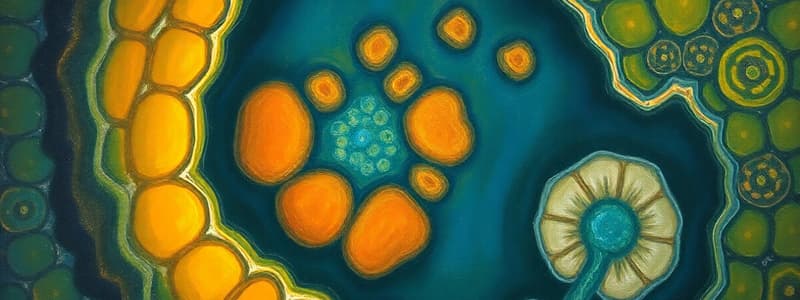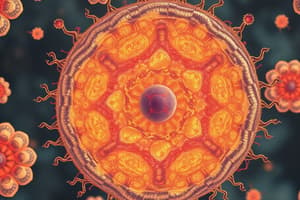Podcast
Questions and Answers
What distinguishes eukaryotic cells from prokaryotic cells?
What distinguishes eukaryotic cells from prokaryotic cells?
- Lack of ribosomes
- Presence of cytoplasm
- Presence of a membrane bound nucleus (correct)
- Size of the cells
Which of the following is a characteristic of ribosomes?
Which of the following is a characteristic of ribosomes?
- They contain genetic material.
- They are membrane bound organelles.
- They play a role in protein synthesis. (correct)
- They are found only in eukaryotic cells.
Which of the following cell organelles is specifically involved in cell division in animal cells?
Which of the following cell organelles is specifically involved in cell division in animal cells?
- Centrosome (correct)
- Lysosomes
- Mitochondria
- Golgi complex
What is the role of cytoplasm in both plant and animal cells?
What is the role of cytoplasm in both plant and animal cells?
What is the approximate size range of typical bacteria cells?
What is the approximate size range of typical bacteria cells?
What is the primary function of mesosomes in prokaryotic cells?
What is the primary function of mesosomes in prokaryotic cells?
Which structures are responsible for the motility of bacteria?
Which structures are responsible for the motility of bacteria?
What are ribosomes associated with in prokaryotic cells?
What are ribosomes associated with in prokaryotic cells?
Which of the following is not a component of a bacterial flagellum?
Which of the following is not a component of a bacterial flagellum?
What do inclusion bodies in prokaryotic cells primarily store?
What do inclusion bodies in prokaryotic cells primarily store?
Flashcards are hidden until you start studying
Study Notes
Cell Structure
- Cells are the basic unit of life.
- All cells have an outer membrane.
- The nucleus is a dense, membrane-bound structure that contains chromosomes.
- Chromosomes contain DNA, which carries genetic information.
- Cells with membrane-bound nuclei are eukaryotic.
- Cells without a membrane-bound nucleus are prokaryotic.
Cytoplasm
- Cytoplasm is a semi-fluid matrix found in both prokaryotic and eukaryotic cells.
- It is the site for many chemical reactions.
Eukaryotic Cell Organelles
- Organelles are membrane-bound structures found in eukaryotic cells.
- Examples include the endoplasmic reticulum (ER), Golgi complex, lysosomes, mitochondria, microbodies, and vacuoles.
- Prokaryotes lack membrane-bound organelles.
Ribosomes
- Ribosomes are non-membrane bound organelles found in all cells.
- They are involved in protein synthesis.
- Ribosomes are found in the cytoplasm, chloroplasts, mitochondria, and rough ER.
Centrosome
- Centrosomes are non-membrane bound organelles found in animal cells.
- They help with cell division.
Cell Size and Shape
- Cells vary in size and shape.
- Mycoplasmas, the smallest cells, are 0.3 µm in length.
- Bacteria can be 3 to 5 µm in length.
Mesosomes
- Mesosomes are membranous structures formed by extensions of the plasma membrane.
- They are involved in cell wall formation, DNA replication, and distribution.
- They also play a role in respiration, secretion, and increasing the surface area of the plasma membrane.
Chromatophores
- Chromatophores are membranous extensions in the cytoplasm of some prokaryotes like cyanobacteria.
- They contain pigments.
Bacterial Flagella
- Flagella help motile bacteria to move.
- They are thin, filamentous extensions from the bacteria's cell wall.
- They are composed of three parts: filament, hook, and basal body.
- The filament is the longest part.
Pili and Fimbriae
- Pili and fimbriae are surface structures found in bacteria.
- Pili are elongated tubular structures made of protein.
- Fimbriae are small, bristle-like fibres.
- They help bacteria to attach to surfaces.
Inclusion Bodies
- Inclusion bodies are reserve materials found in the cytoplasm of prokaryotic cells.
- They are not bound by a membrane.
- Examples include phosphate granules, cyanophycean granules, and glycogen granules.
- Gas vacuoles are found in blue green and purple and green photosynthetic bacteria.
Eukaryotic Cells
- Eukaryotes include protists, plants, animals, and fungi.
- They have extensive compartmentalization of the cytoplasm, with membrane-bound organelles.
Endoplasmic Reticulum (ER)
- The ER is a network of membranous tubules and cisternae.
- It is involved in the transport of substances, protein synthesis, lipoprotein synthesis, and glycogen synthesis.
- There are two types of ER: rough (RER) and smooth (SER).
- RER is studded with ribosomes, which are involved in protein synthesis.
- SER is involved in the synthesis of lipids and steroids.
Golgi Complex
- The Golgi complex is a membranous organelle composed of flattened sacs called cisternae.
- It is involved in the packaging of materials for intracellular and extracellular transport.
- The Golgi complex is closely associated with the ER.
- It is the site of formation of glycoproteins and glycolipids.
- The trans face of the Golgi complex is the mature face, while the cis face is the formation face.
Lysosomes
- Lysosomes are membrane-bound vesicles formed by the Golgi complex.
- They contain hydrolytic enzymes that digest carbohydrates, proteins, lipids, and nucleic acids.
- Their enzymes are optimally active at acidic pH.
Vacuoles
- Vacuoles are membrane-bound spaces found in the cytoplasm.
- They contain water, sap, excretory products, and other materials.
- Vacuoles are bound by a single membrane called the tonoplast.
- Plant vacuoles can occupy up to 90% of the cell's volume.
- Tonoplasts transport ions and other materials into the vacuole.
- Contractile vacuoles in Amoeba are important for osmoregulation and excretion.
- Food vacuoles form by engulfing food particles.
Nucleus
- The nucleus is enclosed by a double-membrane structure called the nuclear envelope.
- The nuclear envelope has nuclear pores that allow RNA and protein molecules to move between the nucleus and the cytoplasm.
- The nuclear matrix (nucleoplasm) contains nucleoli and chromatin.
- Nucleoli are spherical structures where ribosomal RNA synthesis takes place.
- Chromatin is a loose network of nucleoprotein fibres in the interphase nucleus.
- The nucleus controls cell activities and plays a major role in heredity.
Organelle Functions
- The endomembrane system includes the ER, Golgi complex, lysosomes, and vacuoles.
- Centrosomes and centrioles form the basal body of cilia and flagella, which are involved in movement.
- In animal cells, centrioles form the spindle apparatus during cell division.
- Mitochondria are responsible for oxidative phosphorylation and the generation of adenosine triphosphate (ATP).
- They are enclosed by a double membrane. The inner membrane folds into cristae.
- Plastids are pigment-containing organelles that occur in plant cells only.
- Chloroplasts contain chlorophyll and are responsible for capturing light energy for photosynthesis.
- Grana within the plastid are the site of light reactions.
- The stroma is the site of the dark reactions.
- Other colored plastids are called chromoplasts and may contain pigments like carotene and xanthophyll.
Cell: The Functional Unit of Life
- The cell is the structural and functional unit of life.
Studying That Suits You
Use AI to generate personalized quizzes and flashcards to suit your learning preferences.




